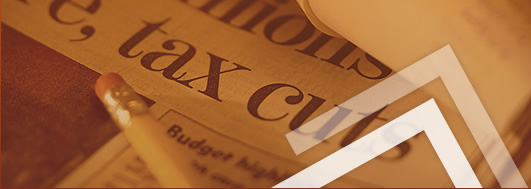

Top tax rate may fall |
|
April 19, 2006 THE Federal Government has more than enough money to give all tax payers a tax cut, with the Budget surplus forecast to exceed $14.5 billion, according to Macquarie Bank. In addition, the Government could easily afford to eliminate the top marginal tax rate of 47 per cent or bring it down to 30 per cent, said Richard Gibbs, an economist with the bank. "Our calculations now indicate that the 2005-06 Budget surplus could exceed $14.5 billion, with corporate tax receipts set to receive yet another boost from the earnings upgrades for Australia's major resource companies," Mr Gibbs said in a research note yesterday. "In our view there should be little argument about the scope for taxation relief given that the Federal Government's Mid-year Economic and Fiscal Outlook (MYEFO) confirmed sizeable upgrades to forecast Budget surpluses over the next four years." The MYEFO says the 2005-06 Budget surplus would swell to $11.5 billion, up from $8.9 billion predicted in the May 2005 Budget. The Government also revised upwards the forecast Budget surpluses for the 2006-07 to 2008-09 fiscal years. This leaves the Government with several options to cut tax rates or increase tax thresholds, according to Macquarie Bank. One way to deliver tax cuts to all tax payers would be through a lift in the tax-free threshold from $6000. It would cost the Government $1.53 billion a year for every $1000 increase to the tax-free threshold. To increase the threshold to $12,000 would cost a whopping $9.2 billion per annum, Macquarie Bank estimates. Rather than any increase to the tax-free threshold, cuts to marginal tax rates would have a much more long-lasting impact on household disposable income, says Mr Gibbs. Macquarie Bank estimates that cuts to all marginal tax rates (that is, 15 per cent, 30 per cent, 42 per cent and 47 per cent) by 2 percentage points would cost around $8 billion a year. "This scenario has the attraction of delivering universal tax relief," says Macquarie Bank. Eliminating the top 47 per cent marginal rate, with a view to addressing the anomaly between the 30 per cent company tax rate and the top tax rate, may be the most cost-effective option open to the Government, says Mr Gibbs. "Given the further uplift in the income threshold for the 47 per cent marginal tax rate from 1 July 2006, eliminating the top marginal tax rate is now approaching its most cost-effective level in respect to the cost to revenue," says Mr Gibbs. He estimates the cost of a 1 percentage point reduction in the 47 per cent rate is less than $450 million per annum. The top marginal tax rate could be eliminated at a cost of around $2.2 billion per annum. The Government may also concentrate on giving tax cuts for low and high income earners, said Mr Gibbs. An increase in the $6000 tax-free threshold to $8000 would cost $3.1 billion per anum. Eliminating the top 47 per cent rate would cost around $2.2 billion per annum. "By concentrating on both ends of the tax scale, the Government would be able to begin to address two key structural anomalies - the obvious discrepancy between the top marginal tax rate and the company tax rate of 30 per cent and excessive steepness of effective marginal tax rates for those moving from welfare to work," said Mr Gibbs. Nicki Bourlioufas is the business editor of news.com.au.
|
|